|
|
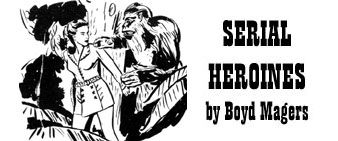
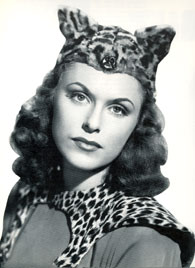 Linda Stirling Linda Stirling
“I made my living getting beat up, tied up and gagged and thrown off a horse.” Linda Stirling is considered the last of the great ‘Serial Queens,’ appearing in six of Republic’s best cliffhangers between 1944-19’6. The native born Californian (October 11, 1921) started dramatic lessons at 12, graduated from high school at 16 and studied at Ben Bard’s Academy of Dramatic Arts for two years.
Modeling led to Republic and the title role in their “Tiger Woman” serial. “I was the last person in the world for that part. I’m not an outdoor girl, I couldn’t ride…my idea of fun was to go to nightclubs and dance. I had done a lot of modeling, print ads and some magazine covers. One of them was a very outdoorsy picture. I looked sort of like an outdoor girl and Republic needed someone right away for ‘The Tiger Woman’. The part had been given to Kay Aldridge who had been under contract to Republic, but just before it was time for the film to start, she eloped, got married and didn’t want to come back. So they were desperate and I got the part. Yates and the upper echelon saw the photo and had me come out for an interview. There were about 10 people at the interview—turned out half of them were stuntmen because they wanted to know if I could do it. They asked if I could do a running dismount…I didn’t even know what it was! (Laughs) Earlier, when my agent told me what it was, I said, ‘I don’t ride. I don’t think I should do this.’ She said, ‘Don’t worry, they always use doubles. You won’t have to do any riding. Just lie and say you can ride.’ Now this was on a Wednesday. So, very dutifully, being a good actress, I lied and said, ‘Oh yes, I can do that.’ And I couldn’t do any of the things they were asking if I could do. They asked me to wait outside for a few minutes. Then the director, Spence Bennett, came out and said, ‘We’d like to see you next Monday. Wear some old jeans (which I didn’t even own) and we wanna see you riding a horse—do the running mounts…’ I went, ‘Uh-oh. I just got myself into a real bad situation.’ I smiled, nodded and left and called my agent and started screaming over the phone, ‘What have you done to me? You’ve made a liar out of me, I can’t do this.’ She said, ‘Why don’t you just try?’ Well, one fellow I’d met had a horse at Ace Hudkins Stable. I called him and said, ‘What am I gonna do?’ He said, ‘I’ll call Ace. He has a lot of movie horses…maybe he can give you some pointers.’ He called Ace and called me back and said, ‘Go out at 6 in the morning.’ Well, I hadn’t been up at 6 in the morning in many years…if ever! (Laughs) I staggered out there and told them, ‘I have to do a running mount, running dismount…but I have to tell you I’ve only been on a horse two times in my life. Both times I fell off.’ Well, we practiced in the ring Thursday and Friday—by Saturday my legs were going in two different directions, I couldn’t walk very well. I had a big hole in the back of my spine where the saddle had rubbed because I didn’t know how to ride properly. But, Monday I went out to Republic. I thought, ‘I haven’t studied all these years and wanted to be an actress for so long—to just to muff this because I haven’t got the courage to give it a try.’ They promised they’d send me the horse I’d been practicing on for four days and the wrangler who knew my problems. When I got there they had me go way down to the end of the western street. I was to come galloping around—full gallop—come to the Duchess’ Ranch, which was a standing set with a little picket fence; I was to come to a running dismount and then jump over the picket fence, go to the door, come back, get back on the horse and gallop off. Well, I got back there—it wasn’t the horse or wrangler I’d been practicing with! The A.D. gave me the signal and the wrangler hit the horse so hard that when he came whirling around the corner, my feet fell out of the stirrups. I came galloping down the street, bumping up and down and the horse was headed right for this huge mob of people including ‘Papa’ Yates…I thought, ‘I’m gonna kill ‘em all off.’ I just closed my eyes and thought, ‘Oh, this is horrible.’ Well, the horse knew better, he just swirled around in front of the Duchess’ Ranch. I didn’t do a running dismount. I was sort of hanging around the horse’s neck, upside down! I started to laugh because the whole thing was so totally
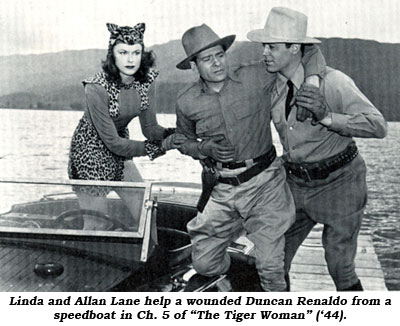 ridiculous. I thought, ‘I’ve made a fool of myself. I might as well hang my head and leave.’ I got down and was laughing because it was such a completely unlikely situation for me to be in. I started to leave but they stopped me and said, ‘You wanna try it again?’ I said, ‘That would be foolish.’ But they said, ‘Try it one more time.’ So I did. This time I stayed in the stirrups, I got around, got off and to the picket fence, but at that point I was finished. I couldn’t even jump over that foot high fence. (Laughs) I said, ‘I surrender.’ And I left. But by the time I got home my phone was ringing and my agent said, ‘You got the part. They liked your humor and attitude.’ They felt I had a lot of guts to try it, so they were gonna take a chance. Later I found out they were in a terrible bind. I came closest to matching the doubles of anyone they’d seen. They had costumes all ready and I was the closest to the actress who was originally supposed to play the part. So that’s the series of events that led to me standing out there (filming) in that skimpy costume in the coldest winter they’d had in California in many, many years. There was ice on the ground at Sherwood Lake where we did some of the jungle parts and I was freezing. Our teeth were chattering. When you watch ‘Tiger Woman’, notice the funny smile on my face. The only way I could keep my lips from trembling was to paste this little smile on…it got stuck. (Laughs)” ridiculous. I thought, ‘I’ve made a fool of myself. I might as well hang my head and leave.’ I got down and was laughing because it was such a completely unlikely situation for me to be in. I started to leave but they stopped me and said, ‘You wanna try it again?’ I said, ‘That would be foolish.’ But they said, ‘Try it one more time.’ So I did. This time I stayed in the stirrups, I got around, got off and to the picket fence, but at that point I was finished. I couldn’t even jump over that foot high fence. (Laughs) I said, ‘I surrender.’ And I left. But by the time I got home my phone was ringing and my agent said, ‘You got the part. They liked your humor and attitude.’ They felt I had a lot of guts to try it, so they were gonna take a chance. Later I found out they were in a terrible bind. I came closest to matching the doubles of anyone they’d seen. They had costumes all ready and I was the closest to the actress who was originally supposed to play the part. So that’s the series of events that led to me standing out there (filming) in that skimpy costume in the coldest winter they’d had in California in many, many years. There was ice on the ground at Sherwood Lake where we did some of the jungle parts and I was freezing. Our teeth were chattering. When you watch ‘Tiger Woman’, notice the funny smile on my face. The only way I could keep my lips from trembling was to paste this little smile on…it got stuck. (Laughs)”
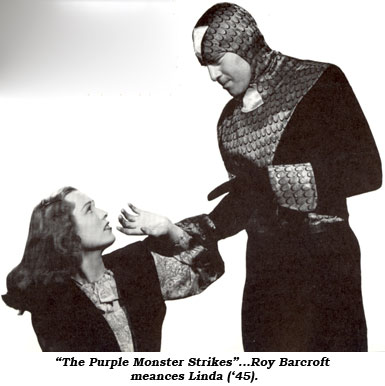 Obviously, making serials was hard work. “We generally did the serials in a month. There was always pressure because all the shooting had to be done before dark. It wasn’t glamorous, believe me! Working hours were long. I was often up at 4am and at the studio by 4:30 for make-up. My hair had to be set and dried each morning so it would exactly match the film already shot. We had to be ready for the first take at 8am sharp, and it generally took about an hour to get to location. We seldom got back to the studio before 8pm. I never seemed to get to bed before 11 or midnight. Then up at 4. I was so tired during a fight sequence aboard a spaceship in ‘Purple Monster Strikes’, that when I was supposed to be knocked out while a fight went on, I fell asleep. But Republic was like a big family. Since we worked on a serial for a month or more, westerns seemed like vacations.” Obviously, making serials was hard work. “We generally did the serials in a month. There was always pressure because all the shooting had to be done before dark. It wasn’t glamorous, believe me! Working hours were long. I was often up at 4am and at the studio by 4:30 for make-up. My hair had to be set and dried each morning so it would exactly match the film already shot. We had to be ready for the first take at 8am sharp, and it generally took about an hour to get to location. We seldom got back to the studio before 8pm. I never seemed to get to bed before 11 or midnight. Then up at 4. I was so tired during a fight sequence aboard a spaceship in ‘Purple Monster Strikes’, that when I was supposed to be knocked out while a fight went on, I fell asleep. But Republic was like a big family. Since we worked on a serial for a month or more, westerns seemed like vacations.”
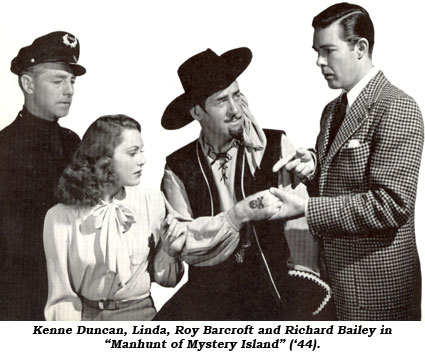 Linda experienced at least one dangerous ‘close call’ in her career. “We were on the process stage making ‘Manhunt of Mystery Island’ In those days, they’d have the process screen behind us moving and we were standing still. It was supposed to be over this huge gorge, miles down. The cameras were set, it was the take out for the chapter ending. The evil guy was cutting the ropes. The leading man, Richard Bailey, was beside me. But, as I turned around, it was Tom Steele standing next to me. All of a sudden they said, ‘Action,’ and Tommy said, ‘Stay with me, let me get under you’…all this is being whispered while we are falling about ten feet to the ground. I’m sure I would have hurt myself if he hadn’t protected me. Tommy got up and started to charge the director—Spence Bennett—I thought Tom was gonna get him. He was go mad…he was livid. He said, ‘You coulda killed her. She doesn’t know how to do this kinda thing.’ He was really angry. It was a kind of silly thing for them to do, but we got late, hurried. Spence Bennett was busy jumping up and down, which he loved to do when he was upset, and wasn’t paying any attention. They just forgot to send the double up.” Linda experienced at least one dangerous ‘close call’ in her career. “We were on the process stage making ‘Manhunt of Mystery Island’ In those days, they’d have the process screen behind us moving and we were standing still. It was supposed to be over this huge gorge, miles down. The cameras were set, it was the take out for the chapter ending. The evil guy was cutting the ropes. The leading man, Richard Bailey, was beside me. But, as I turned around, it was Tom Steele standing next to me. All of a sudden they said, ‘Action,’ and Tommy said, ‘Stay with me, let me get under you’…all this is being whispered while we are falling about ten feet to the ground. I’m sure I would have hurt myself if he hadn’t protected me. Tommy got up and started to charge the director—Spence Bennett—I thought Tom was gonna get him. He was go mad…he was livid. He said, ‘You coulda killed her. She doesn’t know how to do this kinda thing.’ He was really angry. It was a kind of silly thing for them to do, but we got late, hurried. Spence Bennett was busy jumping up and down, which he loved to do when he was upset, and wasn’t paying any attention. They just forgot to send the double up.”
“Once director Spence Bennett asked if I could do a running insert. I said sure, although I had no idea what it was. (The camera car travels ahead of a galloping horse, filming horse and rider.) My horse took it as a personal challenge to outrun the camera truck. I was just along for the ride being bounced around on this galloping horse.”
Stuntlady Babe De Freest doubled Linda in practically everything. “In ‘Zorro’s Black Whip’ there was one stunt they didn’t want Babe to do, a jump from the top of the barn onto a horse as it was galloping by. They thought it was too difficult. So they told Joe (Yrigoyen) to do it; which he did, and fell off the horse and broke his leg. They put his brother Bill (Yrigoyen) there, he missed and ended up in the tree. Babe said, ‘Why don’t you let me do it?’ They weren’t sure, but she did it perfectly. It was a very successful stunt. She was much shorter than I, stockier, but she’s incredible as a double. There were times when we saw the rushes, we would argue about which one of us it was. Most of the time we couldn’t tell. She was amazing.”
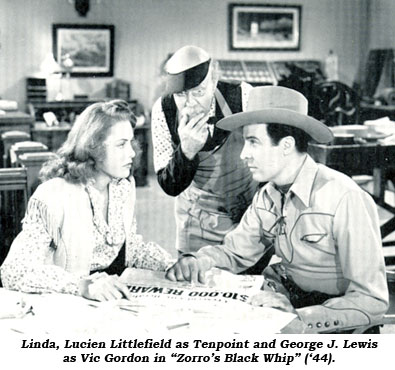 Duncan Renaldo (later the Cisco Kid on TV) worked with Linda on two of her serials, “Tiger Woman” and “Zorro’s Black Whip.” “Duncan was a sweetheart and one of the funniest guys I’ve ever met. Stories all the time. Sometimes he’d be finishing the tag line as we were walking up to shoot the scene. (Laughs) He was irrepressible. He was already part of movie history and knew practically everybody in the business. I really was an eager little actress dying to do it right. Duncan and George J. Lewis were very helpful. They were showing me where the camera was because I had no idea. ‘Don’t look there…look over here…they won’t see your face, they’ll see your profile.’” Duncan Renaldo (later the Cisco Kid on TV) worked with Linda on two of her serials, “Tiger Woman” and “Zorro’s Black Whip.” “Duncan was a sweetheart and one of the funniest guys I’ve ever met. Stories all the time. Sometimes he’d be finishing the tag line as we were walking up to shoot the scene. (Laughs) He was irrepressible. He was already part of movie history and knew practically everybody in the business. I really was an eager little actress dying to do it right. Duncan and George J. Lewis were very helpful. They were showing me where the camera was because I had no idea. ‘Don’t look there…look over here…they won’t see your face, they’ll see your profile.’”
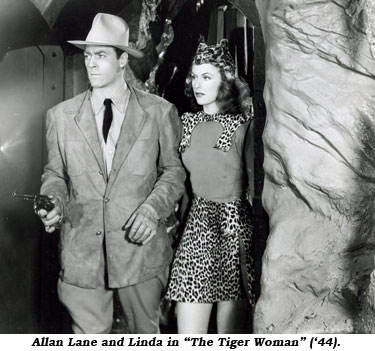 Much has been said and written about Western star Allan “Rocky” Lane’s demeanor over the years. Some say he could be difficult. Linda co-starred with him in “Tiger Woman” and chuckles, “Difficult isn’t exactly a fair word. He was very tense, very up tight, very eager and very professional. I think one of his problems was, he wanted to be perfect. But under the conditions we were working, you can’t really be perfect. You can always do it better. The only thing you had to watch out for was his moves. Because once the camera started rolling, he wanted to be in front of the camera. And if you were too close to him, you just got bumped, so that he could get the whole face—and I’d wind up with only my shoulder or part of my head showing. Time and time again, the director would say, ‘Cut! Allan, move over, give her some room.’ But he’d keep edging over. My hips would be black and blue. (Laughs) Once, at Iverson’s, he was supposed to come down a steep cliff on his horse. It was high so they called the doubles. But Allan said, ‘No, I want it. I’m a good rider. I can do it.’ So he went up. There was dirt and it was slipping…and he fell off. The director was ready to send the double in. But Allan said, ‘No, I’m going to do it.’ He did it four times and fell off four times and he still wouldn’t let the double do it. He was determined he was going to do it…and the fifth time, he did do it. But it wasn’t necessary, they weren’t that close. Who would have known? But that’s the kind of person he was. He’d made up his mind, it was a challenge for him. He wasn’t gonna back down, and didn’t!” Much has been said and written about Western star Allan “Rocky” Lane’s demeanor over the years. Some say he could be difficult. Linda co-starred with him in “Tiger Woman” and chuckles, “Difficult isn’t exactly a fair word. He was very tense, very up tight, very eager and very professional. I think one of his problems was, he wanted to be perfect. But under the conditions we were working, you can’t really be perfect. You can always do it better. The only thing you had to watch out for was his moves. Because once the camera started rolling, he wanted to be in front of the camera. And if you were too close to him, you just got bumped, so that he could get the whole face—and I’d wind up with only my shoulder or part of my head showing. Time and time again, the director would say, ‘Cut! Allan, move over, give her some room.’ But he’d keep edging over. My hips would be black and blue. (Laughs) Once, at Iverson’s, he was supposed to come down a steep cliff on his horse. It was high so they called the doubles. But Allan said, ‘No, I want it. I’m a good rider. I can do it.’ So he went up. There was dirt and it was slipping…and he fell off. The director was ready to send the double in. But Allan said, ‘No, I’m going to do it.’ He did it four times and fell off four times and he still wouldn’t let the double do it. He was determined he was going to do it…and the fifth time, he did do it. But it wasn’t necessary, they weren’t that close. Who would have known? But that’s the kind of person he was. He’d made up his mind, it was a challenge for him. He wasn’t gonna back down, and didn’t!”
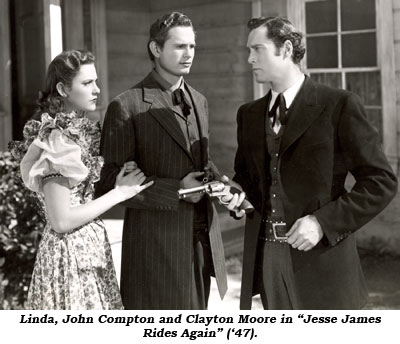 Linda did two serials with Clayton Moore (later the Lone Ranger), “Crimson Ghost” and “Jesse James Rides Again”. “Clayton was very professional, very serious when he was working, very relaxed and cool when he wasn’t. A very likable guy and a good actor. He didn’t clown around a lot when he was getting ready to do a scene. Afterwards OK…and earlier. But when he was working he gave his all, lots of energy, lots of vitality. There’s a scene (at the end of chapter 6) where I’m supposed to be driving a car…it’s out of control and I go ‘Ahhhh—“ and jump out. That was the last scene shot for the picture, doing it in the most convenient way. I was the only one on call that day—and the stuntlady, I don’t remember if it was Babe (DeFreest) or who. Anyway, we had the cast party the night before and we were up very, very late. None of us were feeling any pain by the time we got home. The next morning we were feeling a lot of pain. (Laughs) I came staggering into the studio, got my clothes, got into the truck—Bill (Witney) knew I had a scene to do that day. All I remember is, I was to open the car door and fall out and that’s exactly what I did! (Laughs) Everybody came running over to see if I was alright. (Laughs) All I wanted to do was get it over with so I could go home. That was one of my most realistic scenes I ever played. (Laughs) It seemed to me there was just more humor on the set. Everybody was always making jokes…usually just before we would start our lines which was no help. It’s hard to be serious when you’re still laughing from something someone said. Except the lead, Charles Quigley, he had no sense of humor at all.” (Laughs and makes a square sign.) Linda did two serials with Clayton Moore (later the Lone Ranger), “Crimson Ghost” and “Jesse James Rides Again”. “Clayton was very professional, very serious when he was working, very relaxed and cool when he wasn’t. A very likable guy and a good actor. He didn’t clown around a lot when he was getting ready to do a scene. Afterwards OK…and earlier. But when he was working he gave his all, lots of energy, lots of vitality. There’s a scene (at the end of chapter 6) where I’m supposed to be driving a car…it’s out of control and I go ‘Ahhhh—“ and jump out. That was the last scene shot for the picture, doing it in the most convenient way. I was the only one on call that day—and the stuntlady, I don’t remember if it was Babe (DeFreest) or who. Anyway, we had the cast party the night before and we were up very, very late. None of us were feeling any pain by the time we got home. The next morning we were feeling a lot of pain. (Laughs) I came staggering into the studio, got my clothes, got into the truck—Bill (Witney) knew I had a scene to do that day. All I remember is, I was to open the car door and fall out and that’s exactly what I did! (Laughs) Everybody came running over to see if I was alright. (Laughs) All I wanted to do was get it over with so I could go home. That was one of my most realistic scenes I ever played. (Laughs) It seemed to me there was just more humor on the set. Everybody was always making jokes…usually just before we would start our lines which was no help. It’s hard to be serious when you’re still laughing from something someone said. Except the lead, Charles Quigley, he had no sense of humor at all.” (Laughs and makes a square sign.)
Perennial heavy, Roy Barcroft was a constant for everyone who worked at Republic. “He loved to act. He really enjoyed it. He probably spent more time at the studio than he did at home. I never could tell if he was serious or if he wasn’t. He had this twinkle in his eye and would say things that sounded alright to me, but I had a feeling he meant more than he was saying. But I never could figure out what! He was fun.”
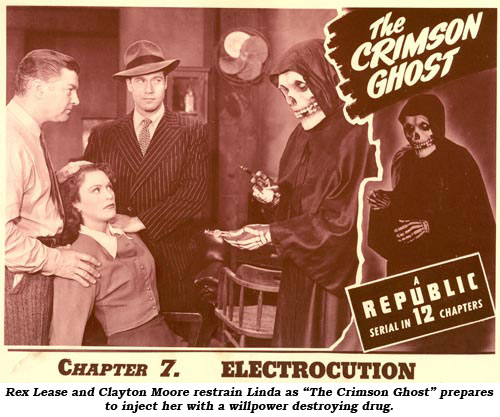
Husband/screenwriter Sloan Nibley was the primary reason Linda left the screen. “I married Sloan in ‘46, left Republic in ‘48 and had a couple of kids. Once my sons were a little older I felt I had to go back to acting, that’s all I’d ever done. I started with half hour TV shows—even did some 15 minute shows. 1952 was the first one. It was fun. I’d been acting since I was 14 and it seemed something was missing. By the late ‘50s I wasn’t working as often, so I thought I’d go to college just for my own enrichment. I got more and more involved and was fascinated to find out how much I didn’t know. After that, I began turning down parts, got more involved and finished up at UCLA. I didn’t intend to be a teacher, that was the last thing in my mind. It just sort of evolved by itself.” Linda subsequently taught English Literature, Irish history and Shakespeare at Glendale College for 27 years, retiring in 1992.
And how would Linda Stirling like to be remembered 100 years from now? “(Laughs) I’ll probably have the Tiger Woman etched on my tombstone.” A prophetic statement. Linda died of cancer shortly after this interview, July 20, 1997.

In Ch. 14 of “Manhunt of Mystery Island”, Linda Stirling’s airplane is sent into a dive via remote control by Capt. Mephisto and audibly crashes into a mountain. In Ch. 15, the plane barely scrapes treetops on the mountain and there is no audible crash. |
top of page
|

